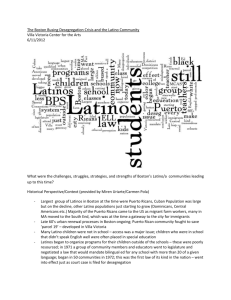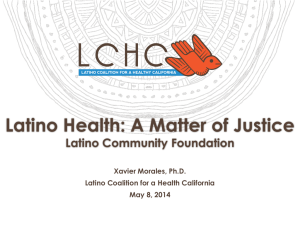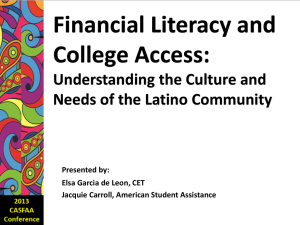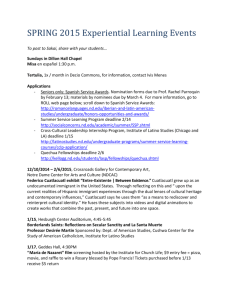I examine Latino policy interests in both chambers of the legislatures
advertisement
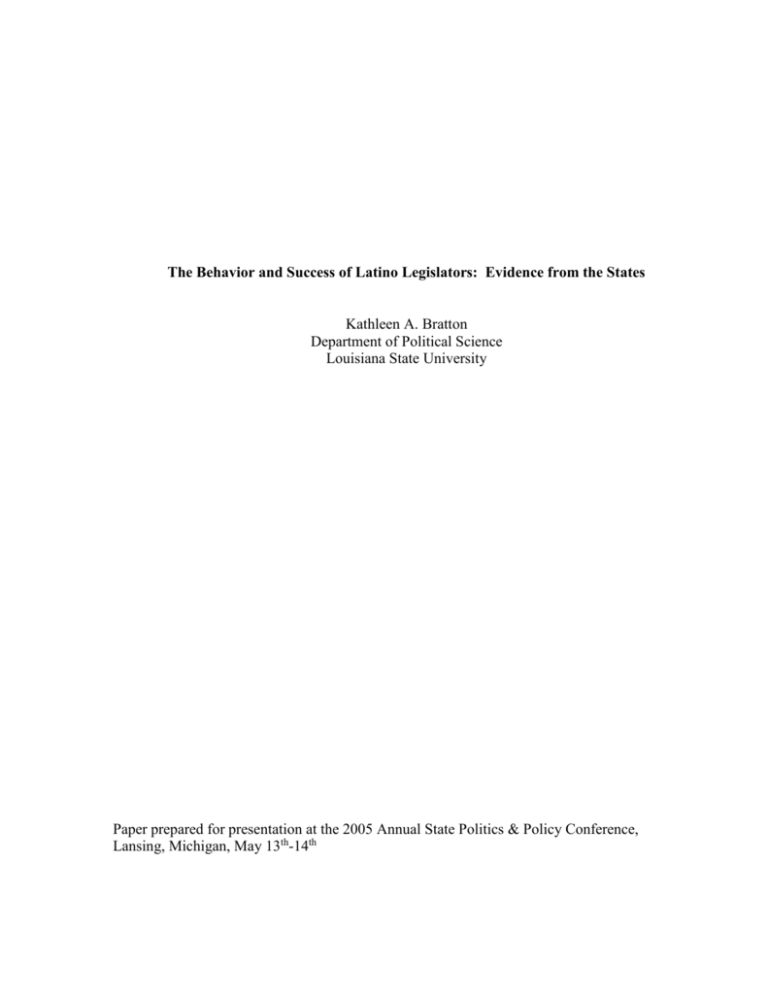
The Behavior and Success of Latino Legislators: Evidence from the States Kathleen A. Bratton Department of Political Science Louisiana State University Paper prepared for presentation at the 2005 Annual State Politics & Policy Conference, Lansing, Michigan, May 13th-14th Abstract In the last two decades, a substantial amount of research has focused on gender and racial differences in legislative behavior, preferences, and success. The work on minority representation, however, has focused almost exclusively on African-American legislators. In the last two decades, Latino representation in state legislatures has more than doubled, yet there is very little research on the policy interests and legislative success of this group. In this paper, I find that Latino representatives in three of the four states studied sponsor more measures focusing on Latino interests, and that Latino representatives are more likely to serve on committees that are relatively likely to meet those interests. Moreover, Latino legislators are more likely to be elected from predominantly Latino, economically disadvantaged districts and legislators elected from those districts are more likely to focus on policies relevant to that constituency. I also find that Latino representatives are as successful as other legislators in passing the bills that they introduce. I conclude that while there are important differences across the states under consideration, there is a link between descriptive and substantive representation of Latinos. The Behavior and Success of Latino State Legislators In the last two decades, a substantial amount of research has focused on gender and racial differences in legislative behavior, preferences, and success (e.g., Bratton and Haynie 1999; Swers 2002). The work on minority representation, however, has focused almost exclusively on African-American legislators. In the last two decades, Latino representation in state legislatures has more than doubled, yet there is very little research on the policy interests and legislative success of this group. In this paper, I examine whether Latino legislators are more likely than other legislators to focus on particular policies, and whether they are as successful as other legislators. The behavior and success of Latino legislators is a particularly interesting focus of study. Latinos face many of the same challenges as other under-represented minority groups. Demographics suggest that Latino elected officials would have a particular interest in policies involving welfare, health, education, and children. Latinos also face particular problems due to the large numbers of recent Latino immigrants. In 2003, the poverty rate for both African-Americans and those of Hispanic origin was nearly three times that of non-Hispanic whites; while real median household income of individuals of Hispanic origin is marginally greater than that for black individuals, the median household income for both groups is well below that for non-Hispanic whites (U.S. Census Bureau 2004). Latino individuals are also more likely than non-Latinos to face acute health problems. Both African Americans and Latinos are less likely than non-Latino whites to be insured; indeed, the percentage of Latinos without health insurance is substantially greater than the uninsured percentage of either African-Americans or non-Latino whites, and the problem is particularly acute for Latino children (U.S. Census Bureau 2004). Latinos are disproportionately likely to have diabetes and to be HIV positive, and Latina teens are more likely to become pregnant; moreover, Latina teen mothers are much less likely to complete high school than white or black non-Latina teen mothers (MartinezEbers et. al. 2000). Latino adolescents are less likely to be enrolled in school (McMillen, Kaufman, and Klein 1997) than African American or white adolescents, and have less positive educational outcomes (Kaao and Tienda 1995); moreover, these differences are not erased with successive generations in the United States (Gans 1992). Some studies have found that Latino students are more segregated than any other group (Crawford 1997), and this is particularly true for students with limited proficiency in English. Such students face substantial problems in educational achievement, given the limited number of teachers certified to instruct such students (Diaz-Rico and Smith 1994). However, despite these challenges, it is important to recognize that Latinos are a remarkably diverse group. Experiences and outcomes among Latino immigrants have been shown to vary across countries of origin. Patterns of Mexican immigration into the United States, for instance, are much different than patterns of Cuban immigration: Cubans are more likely to emigrate for political reasons, and more likely to quickly integrate into a supportive environment (Portes and MacLeod 1996). Mexicans are more likely to emigrate for purely economic reasons, and are more likely to lack legal status in the United States. This produces persistent differences in the obstacles that the two groups face, in part because family differences in educational and economic achievement continue across generations (Schmid 2001). Cuban immigrants, for instance, are much less likely to have low educational outcomes than Mexican Americans (Portes and MacLeod 1996). Moreover, Latinos in the mass public are a relatively diverse group in partisanship and public opinion. While Latinos in the mass public tend to identify themselves as Democrats and vote for Democratic candidates (Hero et al 2000), they are not as homogeneous in this respect as African-Americans. Indeed, most Cuban Americans identify with the Republican party (de la Garza et al 1992) Moreover, some evidence exists that Latino identification with the Democratic Party may be relatively weak (Connaughton 2004). Are the distinctive opinions and life chances of Latinos reflected in the legislative arena? In this paper, I examine the behavior and success of Latino legislators at several stages of the legislative process: agenda-setting through bill sponsorship, committee membership, and success in bill passage. I expect that Latino legislators will be more likely than their white non-Latino colleagues to focus on such policies as education, health care, children’s policy, and welfare, as well as policies that are explicitly designed to aid an immigrant or Latino population. I also examine whether these interests are reflected in distinct patterns of committee assignments. Finally, I examine whether Latino legislators are as successful as their colleagues at passing the legislation that they sponsor. The Substantive Representation of Latinos: Policy Interests and Preferences, and Legislative Success What little research exists on Latino representation focuses primarily on roll-call voting behavior. In a study of U.S. House members from 1973 to 1980, Welch and Hibbing (1984) found that Latino representatives were somewhat more liberal than nonLatino representatives. On the other hand, using Southwest Voter Research Initiative (SWVRI) scores, Hero and Tolbert (1995) found few differences in the 100th Congress. Kerr and Miller (1997) find significant differences in SWVRI scores. They argue as well that even in the absence of such differences, Latino representatives may be representing substantively, because insignificant coefficients for ethnicity may merely signify that non-Latino representatives are also supporting Latino interests. Using DW Nominate scores, Lublin (1997) finds that the composition of the district exerts a powerful influence on voting behavior in Congress; Republican representatives elected from districts with a high proportion of Latinos are relatively conservative, whereas Democratic representatives elected from such districts are relatively liberal. Casellas (2002) finds that Mexican and Puerto Rican representatives are more liberal than other non-black representatives in the 87th through 104th Congress. Additional research has been done on the influence of Latino representation on voter alienation and participation; Pantoja and Segura found that representation by Latinos in the state legislature was associated with a small decrease in political alienation among Latinos in Texas and California. Some research has also focused on the influence of Latino representation on policy outputs; Fraga, Meier and England (1986) found that Latino representation on school boards was a significant predictor of employment of Latino teachers. Very little research has been done on the policy interests of Latino legislators, as expressed through their sponsorship behavior, or on the success of Latino sponsored legislation. Substantial work has been done on the distinctiveness of African-American and female legislators at these stages of the legislative process. Several authors have argued that sponsorship provides an excellent point at which to examine racial and sex differences in legislative policy interests. Agenda-setting is a crucial point in any policymaking endeavor (Bachrach and Baratz 1963; Kingdon 1989), and can affect policy preferences and outcomes by redefining the set of alternatives. Bill sponsorship in particular can be seen as a signal of a high level of expertise and interest in a particular policy area. Moreover, legislators have a high degree freedom to define their interests at the sponsorship stage of the legislative process, and are not constrained to a yes-no vote on an already existing measure. Prior research has consistently shown significant differences in the sponsorship behavior of legislative minorities such as African-Americans and women, even when controlling for partisanship and district composition (Bratton 2002; Haynie 2000; Swers 2002). Women have consistently been shown to be more likely to sponsor legislation involving education, health care, children’s policy, welfare policy, as well as measures explicitly designed to decrease gender discrimination or alleviate the effects of such discrimination, improve the socioeconomic status of women, or address sex-specific policy needs (Bratton 2005; Swers 2002). African American legislators are likewise significantly more likely than other legislators to focus on policies involving education and welfare, as well as measures explicitly designed to address black interests (Bratton and Haynie 1999). Given the challenges outlined above that disproportionately affect Latinos, it is reasonable to expect that Latinos in the mass public and at the elite level do focus on a similar set of issues. Therefore, I test the following hypotheses: H1. Compared to non-Latino whites Latino legislators will be sponsor a relatively high number of measures involving health, education, welfare, and children, as well as legislation addressing Latino interests. H2: Legislators elected from districts with a high proportion of Latino residents will sponsor a relatively high number of legislative measures involving health, education, welfare, and children, as well as legislation that addresses Latino interests. H3: Latinos will be more likely than non-Latino whites to serve on legislative committees focusing on health, welfare, and education. Prior research has also addressed the success of legislative minorities such as African-Americans and women. Women have consistently been shown to be as successful in passing legislation as men (Saint-Germain 1989; Thomas 1994), even in the 1960s, when they were a novel presence in state legislatures (Bratton 2005). Racial differences, however, have been shown to be more evident. Bratton and Haynie (1999) argued that group boundaries between African Americans and whites might make it more difficult for bills sponsored by African-Americans to pass. They reported that in three of the six states studied (Arkansas, California, and Illinois), measures sponsored by African Americans were significantly less likely to pass than other measures, even when controlling for a host of other likely influences on bill passage. Such obstacles may also be present for Latino legislators. Measures of segregation clearly demonstrate significant segregation of ethnic minorities such as Latinos, and there is little question that Latinos face discrimination. It is difficult, however, to confidently generalize this finding to Latino legislators. The last year considered in Bratton and Haynie’s study was 1989, and it is unclear whether AfricanAmericans would be similarly disadvantaged in more recent years. In addition, as noted above, Latinos tend to be more politically diverse than African-Americans; we know that the sponsor of a measure serves as a cue regarding the content of the measure (Kingdon 1989), and it is possible that race serves as a more powerful cue than ethnicity. Indeed, as the structure of the US census points out, ethnicity is a concept that transcends racial boundaries. Given this, I pose two competing hypotheses: H4a: Measures sponsored by Latino legislators will be less likely to pass than measures sponsored by non-Latino legislators. H4b: Measures sponsored by Latino legislators will be as likely to pass as measures sponsored by non-Latino legislators. Data I examine Latino policy interests in 2001 in both chambers of the legislatures in four states: California, Florida, Illinois, and Texas. These states offered variance in the level of professionalism and the party that controlled each chamber; they were also suitable because the proportion of African-Americans, women, and Latinos within the chamber was relatively high. Moreover, Illinois and California were two of the three states in which earlier studies found significant racial differences in bill passage, and this study provides an opportunity to update that finding. Latino legislators were first identified through a 2003 list from the National Conference of Hispanic State Legislators; newspaper searches and searches of state documents were also done to add any Latino legislators who were not included on that list. Legislators were only considered Latino if explicit evidence regarding their Latino identity could be found. Table 1. presents descriptive information on the legislators serving in these chambers. [Table 1 About Here] All bills sponsored in each chamber were content coded for subject area. Only substantive proposals were considered; resolutions were not included in the analysis. Bills could be placed in more than one category. Introducer lists found in the various state legislative documents were used to match legislators with their proposals. When a distinction was made between primary and secondary sponsors, only primary sponsors were included (though bills could have multiple primary sponsors). Six general policy areas were considered: Latino interests, black interests, education, health, welfare, and children’s policy. “Black interests” were measures that may decrease racial discrimination or alleviate the effects of that discrimination, or were designed to improve the socioeconomic status of African-Americans. Some examples are: funding for research on sickle-cell anemia, the inclusion of black history in the K-8 curriculum, or tax incentives for minority-owned businesses. “Latino interests” were likewise measures that might decrease discrimination against Latinos or alleviate the effects of that discrimination, or were designed to improve the socioeconomic status of Latinos. The most common such legislation involved anti-discrimination (fair labor and fair housing) measures banning ethnic discrimination; programs designed to address needs specific to Latinos (such as programs designed for LEP (Limited English Proficiency) students, programs designed to highlight Latino contributions to American society, or programs designed to address Latina teen pregnancy); and programs designed to protect the health, welfare, and safety of migrant workers or new or illegal immigrants. Bills could be (and often were) placed in multiple categories. For instance, if an anti-discrimination bill included both Latinos and African-Americans as protected groups, it was considered to be both a “black interest” measure and a “Latino interest” measure. Likewise, a number of measures that were “Latino interest” measures were also coded as health measures (for instance, a measure designed to reduce Latina teen pregnancy), education measures (for instance, bilingual education measures), or welfare measures (for instance, programs designed to provide assistance to poor immigrant communities set up near the Mexican border). For more information on the other subject categories, please see the Appendix. Methods The unit in the agenda-setting analysis is the legislator, and the dependent variable is the number of bills sponsored in a particular subject area. Negative binomial regression is used; this is an appropriate method where the dependent variable is an event count, where the likelihood of an additional event happening decreases as the number of events increases, and where the likelihood of a single event happening is not independent of the likelihood of another event happening (King 1988). That is, negative binomial regression analysis is appropriate because legislators tend to specialize. A legislator who is likely to introduce a measure in a particular subject category is more likely than other legislators to introduce additional measures in that category. Because Latinos are such a diverse group politically, separate analyses are conducted for Florida (where Latino state legislators tend to be Cuban, and affiliated with the Republican party) and the remaining three states (where Latino state legislators tend to be of either Mexican or Puerto Rican descent, and affiliated with the Democratic Party). Using pooled data from California, Illinois, and Texas, six negative binomial regression analyses are conducted, one regression for each bill category. In addition to the race, ethnicity, and sex of the legislator, I control for a number of likely influences on sponsorship choices. Gender, partisanship, and membership on a relevant committee influence the likelihood that a legislator will focus on particular issues (Bratton 2002;; Swers 2002); therefore, I control for the party affiliation, gender, and committee membership of the legislator. Also, it is possible that sponsorship choices are influenced not only by the race, gender, and sex of the legislator, but also by the composition of the legislative district. Therefore, I include in the analysis controls for the percentage Latino in the district, the percentage black in the district, and the average income in the district, as indicated in the State Legislative Databook. I also control for the number of bills sponsored outside of a particular category. Because this is a pooled cross-sectional analysis, I include dummy variables for state-chamber in the analysis to control for fixedeffects on the dependent variable. For Florida, a parallel set of six negative binomial regression analyses are conducted. A similar set of analyses is conducted to predict committee membership. Committees were placed in several categories, including education, health, and welfare committees. (Children’s committees were not analyzed, as they tended to be a subset or combination of the three committees in question.) One logistic regression analysis for each of the three committee areas is performed for the data from California, Illinois, and Texas. Three separate analyses (one for each committee area) were conducted for Florida. As above, I control for the ethnicity, race, and gender of the legislator, as well as for the legislator’s party. I also control for the percentage Latino district, the percentage black in the district, and the average income in the district, as well as for the statechamber dummy variables. Finally, to test racial and ethnic differences in bill passage, I calculate average passage rates for African Americans and non-African Americans, and for Latinos and non-Latinos, in each state. I restrict these analyses to the party with which Latinos tend to be affiliated; in California, Illinois, and Texas, a large majority of Latino legislators are affiliated with the Democratic party, whereas in Florida, almost all Latino legislators are Republican I conduct difference of means tests to discern any ethnic or racial disparity in bill passage among Democrats in California, Illinois, and Texas. For Florida, I test for racial differences among Democrats, and ethnic differences among Republicans. Results The results for the bill sponsorship analyses are presented in Table 2 (California, Illinois, and Texas) and Table 3 (Florida). [Tables 2 and 3 About Here] In the three states presented in Table 2, there are no sponsorship differences between Latino and non-Latino legislators for five of the six subject categories studied. Only in the “Latino interest” category do significant ethnic difference emerge; Latino legislators sponsor significantly more legislation focusing on Latino interests than do their non-Latino colleagues. Thus my first hypothesis is only partially supported in these three states, and it appears that ethnic differences in sponsorship emerge primarily on measures which are fairly narrowly tailored to address Latino interests. However, the pattern of significance across the other parameter estimates suggests that Latinos are representing substantively. First, strong party effects are evident in two policy areas: Republicans are less likely to introduce measures involving welfare policy and / or Latino interests. This suggests that, at least in the states in which Latino legislators tend to be Democrat, both non-Latino and Latino legislators focus on these policies. This possibility is underscored by the analyses presented in Table 3, on the Florida state legislature. Latinos appear to have the same policy interests as their nonLatino Republican colleagues; there is no significant effect of ethnicity for any of the policy areas. Second, in both sets of analyses, legislators elected from less wealthy districts sponsor a relatively high number of welfare policy measures; as Table 1 indicates, the median income of districts represented by Latino legislators is significantly lower than the median income of other districts. And third, in California, Illinois, and Texas, individuals elected from districts with a relatively high percentage of Latino residents sponsor significantly more legislation focusing on welfare policy and Latino interests, thus providing partial support for Hypothesis 2, and suggesting that individuals elected from predominantly Latino districts – including Latinos – do indeed focus on particular interests. Other factors such as gender and race also influence sponsorship choices. Consistent with earlier work, African American legislators sponsor significantly more education and black interest measures than other legislators. Contradicting the earlier work, however, there are no racial differences in the sponsorship of welfare policy; however, the average income in the district, a measure that was unavailable in prior work, does appear to strongly influence sponsorship of welfare policy measures. And, also consistent with earlier work, the sex of the legislator appears to be one of the most consistent predictors of sponsorship; women have distinctive policy agendas. Membership on a relevant committee is also a powerful influence on sponsorship activity. It is possible that Latino legislators express policy interests through distinctive patterns of committee membership, as expressed in Hypothesis 3. The results from the committee membership analysis are presented in Table 4. [Table 4 About Here] The results in Table 4 provide partial support for my third hypothesis: Latinos in the first three states under consideration are significantly more likely to serve on education and health committees. In combination with the results above, this suggests that there is an indirect effect of ethnicity – working through committee membership – on the sponsorship of education and health measures. Again, the results also underscore the importance of considering differences among Latino legislators: in Florida, there are no ethnic differences in committee service. Moreover, the results again underscore the importance of gender differences in policy interests: women are more likely to serve on education and health committees, and the parameter estimate for welfare committees falls just short of conventional significance levels. Finally, are Latino legislators as successful as other legislators? The mean passage rates presented in Table 5 suggests that they are as successful, thus supporting Hypothesis 4b. [Table 5 About Here] There are no significant differences in passage rates between Latino and non-Latino legislators of the same party. Moreover, these results suggest that racial differences in passage may have largely disappeared; Bratton and Haynie found that in the California House, across 1969, 1979, and 1989, African Americans passed a lower proportion of their sponsored measures than other legislators (53% versus 58%), and that measures sponsored by African American legislators were significantly less likely to pass, even when taking into account such factors as majority party affiliation, leadership positions, seniority, and bill characteristics. In Illinois, the same was true, but racial differences in passage rates were even more marked: African-Americans passed about 38% of the measures they sponsored, whereas the passage rates of other legislators averaged about 51%. In this study, covering a much more recent time period, there are no significant racial differences in passage rates. Conclusions Several conclusions can be drawn from this study. First, it is clear that Latino legislators in California, Illinois, and Texas were relatively likely to focus on the sorts of policies that address the challenges of the Latino community in these states. Latino legislators in these states sponsored significantly more “Latino interest” measures than their colleagues, Moreover, a substantial majority of these legislators were Democrats, and Democrats sponsored a significantly higher number of welfare measures than did Republicans. Latino legislators also were more likely to represent relatively poor, predominantly Latino districts, and legislators elected from such districts were relatively likely to focus on welfare policy and Latino interests. And, Latino legislators in these states were significantly more likely to serve on an education or health committee, and such service was a powerful influence on the number of education or health measures introduced. Second, it is clearly important to consider differences across Latino legislators when assessing their policy interests and behavior. Marked differences existed between the sample of Florida legislators and the sample of legislators from the three other states. No such differences were demonstrated in Florida. Indeed, Latino legislators in Florida seemed to have the same policy interests as their other Republican colleagues, and the composition of the district seemed to have little effect in determining sponsorship choices. This suggests that Latino representatives in Florida – generally of Cuban descent and affiliated with the Republican party – see “Latino interests” much differently than Latino representatives elsewhere. Third, this research both reaffirms earlier findings regarding the effects of gender and race on legislative behavior, and introduces some new insights regarding race. It is clear that the sex of the legislator continues to be a powerful influence on policy interests and committee service. African Americans likewise sponsor a significant number of black interest measures and education measures, but no racial differences were found in the sponsorship of welfare policy measures. Moreover, racial differences in legislative success demonstrated in prior work covering earlier time periods appear to have largely disappeared. Both Latinos and African-Americans appear to have distinctive policy interests, and both appear as successful as other legislators at passing their proposals into law. Works Cited Bachrach, Peter, and Morton Baratz. 1963. “Decisions and Nondecisions: An Analytical Framework.” American Political Science Review 57(3): 632-42. Bratton, Kathleen A. 2005. “Critical Mass Theory Revisited: The Behavior and Success of Token Women in State Legislatures.” Politics and Gender. Forthcoming. Bratton, Kathleen A. 2002. “The Effect of Legislative Diversity on Agenda Setting: Evidence From Six State Legislatures.” American Politics Research 30(2): 115142. Bratton, Kathleen A. and Kerry L. Haynie. 1999. “Agenda-Setting and Legislative Success in State Legislatures: The Effects of Gender and Race.” The Journal of Politics 63(3): 658-79. Casellas, Jason P. 2002. “Latino Representation in the U.S. Congress: To What Extent are Latinos Substantively Represented?” Paper presented at the Annual Meeting of the Southern Political Science Association, Savannah, Georgia, November 6-9, 2002. Connaughton, Stacey L. 2004. “Multiple Identification Targets in Examining Partisan Identification: A Case Study of Texas Latinos.” Howard Journal of Communication 15(3): 131-145. Crawford, James. 1997. Best Evidence: Research Foundations of the bilingual Education Act. Washington, DC: National Clearinghouse for Bilingual Education. De la Garza, Rudolfo, Louis DeSipio, F. Chris Garcia, John A. Garcia, and Angelo Falcon. 1992. Latino Voices: Mexican, Puerto Rican, and Cuban Perspectives on American Politics. Boulder: Westview. DeNavas-Walt, Carmen, Bernadette D. Proctor, and Robert J. Mills, U.S. Census Bureau Current Population Reports, P60-226, Income, Poverty, and Health Insurance Coverage in the United States: 2003, U.S. Government Printing Office, Washington, DC, 2004. Diaz-Rico, Lynne, and Jerilynn Smith. 1994. “Recruiting and Retaining Bilingual Teachers as a Cooperative Community-University Model.” The Journal of Educational Issues of Language Minority Students 14(Winter): 255-68. Fraga, Luis Ricardo, Kenneth J. Meier, and Robert E. England. 1986. “Hispanic Americans and Educational Policy: Limits to Equal Access.” Journal of Politics 48(4): 850-876. Gans, Herbert. 1992. “Second Generation Decline: Scenarios for the Economic and Ethnic Futures of the Post-1965 American Immigrants.” Ethnic and Racial Studies 15: 173-93. Hero, Rodney, F. Chris Garcia, John Garcia, and Harry Pachon. 2000. “Latino Participation, Partisanship, and Office Holding.” PS: Political Science and Politics 33(3): 529-534. Hero, Rodney E. and Caroline Tolbert. 1995. “Latinos and Substantive Representation in the U.S House of Representatives: Direct, Indirect, or Nonexistent? American Journal of Political Science 39: 640-52. Kao, Grace and Marta Tienda. 1995. “Optimism and Achievement: The Educational Performance of Immigrant Youth.” Social science Quarterly 76: 1-19. Kerr, Brinick, and Will Miller. 1997. “Latino Representation, It’s Direct and Indirect.” American Journal of Political Science 41(3): 1066-1071. King, Gary. 1988. “Statistical Models for Political Science Event Counts: Bias in Conventional Procedures and Evidence for the Exponential Poisson Regression Model.” American Journal of Political Science 32(3): 838-63. Kingdon, John. 1989. Congressmen’s Voting Decisions. 3rd Edition. Ann Arbor: University of Michigan Press. Lublin, David. 1997. The Paradox of Representation: Racial Gerrymandering and Minority Interests in Congress. Princeton, NJ: Princeton University Press. Martinez-Ebers, Valerie, Luis Fraga, Linda Lopez, and Arturo Vega. 2000. “Latino Interests in Education, Health, and Criminal Justice Policy.” PS: Political Science & Politics 33(3): 547-554. McMillen, Marilyn, Phillip Kaufman, and Steve Klein. 1997. Dropout Rates in the United States: 1995. (NCES Publication 97-473). Washington, DC: U.S. Department of Education. Pantoja, Adrian, and Gary M. Segura. 2003. “Does Ethnicity Matter? Descriptive Representation in Legislatures and Political Alienation Among Latinos.” Social Science Quarterly 84(2): 441-460. Portes, Alejandro, and Dag MacLeod. 1996. “Educational Progress of Children of Immigrants: The Roles of Class, Ethnicity, and School Context.” Sociology of Education 69: 255-75. Rumberger, Russell. 1995. “Dropping Out of Middle School: A Multlevel Analysis of Students and Schools.” American Educational Research Journal 32: 583-625. Saint-Germain, Michelle A. 1989. “Does Their Difference Make a Difference? The Impact of Women on Public Policy in the Arizona Legislature.” Social Science Quarterly 70(4): 956-68. Schmid, Carol L. 2001. “Educational Achievement, Language-Minority Students, and the New Second Generation.” Sociology of Education 74: 71-87. Thomas, Sue. 1994. How Women Legislate. New York: Oxford University Press. Welch, Susan, and John Hibbing. 1984. “Hispanic Representation in the U.S. Congress.” Social Science Quarterly 65: 328-35. Appendix (From Bratton and Haynie (1999)) Bills could be placed in more than one category. Introducer lists found in the various state legislative documents were used to match legislators with their proposals. When a distinction was made between primary and secondary sponsors, only primary sponsors were included (though bills could have multiple primary sponsors). Education measures generally were those involving education curriculum, education personnel, regulation of students, school board policies and regulations, and financing of education, from pre-kindergarten through higher education (including vocational and adult education). Health policy legislation generally included measures to address illnesses; policies regarding the handicapped and disabled; health insurance, Medicare, and Medicaid; regulation of medical facilities, personnel, equipment, training and treatment; and policies addressing the needs of the aging. Children’s policy included such issues as juvenile court policy; child protection policy; child care; child custody and support; foster care and adoption of children; or children’s health. Welfare policy included measures that may alleviate poverty and measures regulating government aid to the poor and to needy areas, such as policies dealing with public aid, Medicaid, TANF, utility lifelines, SSI, food stamps, low-income housing, and homelessness; policies addressing the minimum wage and unemployment; foster care; or educational or health aid for underserved or low-performing areas. Table 1. Descriptive Information, Latino and Non-Latino Legislators, California, Florida, Illinois, and Texas Latino Legislators California Democrat Average Income in District Percentage Latino in District Number of Bills Sponsored 27 89% 38,059 19.99% 28.0 Non-Latino Legislators 94 58% 47,602 47.33% 21.9 Florida Democrat Average Income in District Percentage Latino in District Number of Bills Sponsored 14 7% 38,863 62.64% 14 149 38% 36,051 7.29% 13.9 Democrat Average Income in District Percentage Latino in District Number of Bills Sponsored 7 100% 27,037 65.14% 16.1 176 47.7% 41,093 5.51% 21.1 Democrat Average Income in District Percentage Latino in District Number of Bills Sponsored 35 97% 27,083 67.09% 36.6 146 40% 36,739 16.07% 29.2 Illinois Texas Table 2. California, Illinois, and Texas: Negative Binomial Regression Analysis of Number of Bills Sponsored a (Standard Errors in Parentheses) Education Bills Introduced Health Bills Introduced Welfare Bills Introduced Children’s Bills Introduced Black Interest Bills Introduced Latino Interest Bills Introduced Intercept .444* (.268) .179 (.259) -.597* (.358) -1.161** (.343) -5.262** (1.002) -3.319** (.693) African-American Legislator .535* (.321) -.409 (.300) -.151 (.383) .229 (.351) 2.762** (.993) 1.690* (.711) Female Legislator .225* (.115) .314** (.113) .362** (.145) .213 (.142) .901** (.346) .425** (.237) Latino/a Legislator .065 (.219) -.049 (.206) -.008 (.261) .345 (.263) .293 (.708) .948** (.406) Republican Legislator -.185 (.125) -.114 (.124) -.343* (.168) .027 (.163) -.847 (.548) -.908** (.378) Percent Hispanic in District .005 (.004) .001 (.004) .011* (.005) .006 (.005) .023* (.134) .025** (.008) Percent Black in District -.007 (.006) .006 (.006) .004 (.007) .007 (.007) -.014 (.021) -..012 (.015) Average Income in Districtb .004 (.005) -.003 (.005) -.014* (.006) .007 (.006) .032* (.015) .014 (.012) Membership on Relevant Committee .844** (.120) .733** (.123) .758** (.167) .786** (.163) -.027 (.398) -.024 (.245) .038** (.005) .025** (.004) .028** (.008) .021** (.006) Total Number of .017** .035** (Other) Bills (.003) (.004) Sponsored Sample size: 485 legislators a : Dummy variable controls included for state-chamber b : In thousands * : p<.05, one-tailed test ** : p<.01, one-tailed test Table 3. Florida: Negative Binomial Regression Analysis of Number of Bills Sponsoreda (Standard Errors in Parentheses) Education Bills Introduced Health Bills Introduced Welfare Bills Introduced Children’s Bills Introduced Black Interest Bills Introduced Latino Interest Bills Introduced Intercept -.701 (.674) 1.078* (.586) 1.471* (.809) -.178 (.849) -.186 (2.727) .923 (2.618) African-American Legislator .555 (.521) -.103 (.462) .338 (.595) -.279 (.577) .484 (1.539) .079 (1.467) Female Legislator .331 (.205) .454** (.172) .647** (.235) .374 (.249) .190 (.567) .250 (.545) Latino/a Legislator .042 (.678) -.094 (.575) -.281 (.928) -.334 (.870) 2.554 (.1880) 1.935 (1.778) Republican Legislator .137 (.229) .005 (.192) -.711** (.252) -.570* (.264) .915 (1.121) .528 (1.007). Percent Hispanic in District .007 (.010) -.001 (.009) .006 (.013) .006 (.013) -.001 (.026) .012 (.024) Percent Black in District .001 (.012) -.007 (.011) -.029* (.015) -.002 (.013) .041 (.034) .036 (.034) Average Income in Districtb .016 (.013) -.014 (.012) -.029* (.017) .007 (.017) -.114* (.063) -.140** (.064) Membership on Relevant Committee .518** (.175) .092 (.249) .703** (.294) .699 (.527) .322 (.506) .020** (.009) .017 (.011) .014 (.023) .022 (.019) .604** .154) Total Number of .022** .021** (Other) Bills (.007) (.008) Sponsored Sample size: 163 legislators a : Dummy variable controls included for chamber b : In thousands * : p<.05, one-tailed test ** : p<.01, one-tailed test Table 4. Influences on Committee Assignments: Logistic Regression Analysis (Standard Errors in Parentheses) California, Illinois, Texas Education Committee Health Committee Florida Welfare Committee Education Committee Health Committee Welfare Committee Intercept -.963* (.495) -.951* (.505) -2.068** (.571) -1.096 (1.173) -.822 (1.237) -2.600* (1.428) African-American Legislator .392 (.575) .135 (.621) -1.021 (.627) 1.599 (.990) .291 (1.051) -.145 (1.097) Female Legislator .501* (.219) .817** (.225) .405 (.251) .093 (.397) Latino/a Legislator 1.199** (.448) 1.262** (.477) .139 (.498) .411 (1.205) 1.557 (1.305) -1.556 (1.869) Republican Legislator -.008 (.237) -.562* (.248) -.256 (.271) .309 (.434) -.540 (.441) .557 (.541) Percent Hispanic in District -.018* (.008) -.029** (.009) .001 (.009) -.006 (.018) -.028 (.020) .006 (.026) Percent Black in District .003 (.012) -.008 (.012) .023* (.012) -.012 (.023) -.024 (.025) .022 (.025) Average Income in Districtb -.002 (.010) .001 (.010) .003 (.012) .012 (.025) .018 (.026) .015 (.030) Sample size: 163 legislators a : Dummy variable controls included for chamber b : In thousands * : p<.05, one-tailed test ** : p<.01, one-tailed test .992** (.410) .629 (.437) Table 5. Passage Rates, Latinos and Non-Latinos, and African-Americans and Non African-Americans Passage Rates California (Democrats) Latinos .63 Non-Latinos .71 Passage Rates African-Americans .65 Non African-Americans .69 Florida .26 .30 (Republicans) (Republicans) .13 (Democrats) .16 (Democrats) Illinois (Democrats) .30 .23 .24 .24 Texas (Democrats) .38 .38 .36 .38 * : p<.05


